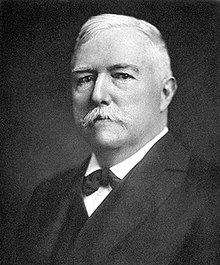Edward Barnard
Edward Emerson Barnard (born December 16, 1857 in Nashville , Tennessee , † February 6, 1923 ) was an American astronomer . He was one of the pioneers in astrophotography , especially the Milky Way. Many of his images of emission and dark nebulae are unsurpassed to this day.
From autodidact to professional astronomer
Edward Barnard was born to Reuben Barnard and Elizabeth Jane. Haywood born. His father died before he was born and the son grew up in poor conditions. At the age of nine he became a helper in a photo studio and proved to be technically gifted. When he found a damaged lens on the street, he built his first telescope with it and began observing the sky.
Barnard was self-taught and was only able to buy a 5-inch telescope in 1876 ; the $ 380 was his half year earnings. Five years later he discovered his first comet . In the following years, Barnard was so successful as a comet seeker that he was able to finance a house for himself and his young wife from the premiums offered by a sponsor for (US) comet discoveries. A special case was comet 1886 II , which he discovered in 1885 , whose orbit changed from an elongated ellipse to a hyperbolic orbit due to orbit disturbances .
At a scientific conference he met Simon Newcomb , who motivated the knowledge-hungry young man to learn mathematics. At the same time he received a scholarship to study at Vanderbilt University , which he graduated at the age of 30. During this time he was also in charge of the Vanderbilt University Observatory there . Then in 1888 he worked at the newly established Lick Observatory with what was then the world's largest 36-inch giant telescope .
Photographic Milky Way Research
In 1892 he observed a nova and was the first to register an expanding gas cloud . From this he deduced that it must be the explosion of a star. In the same year he discovered the fifth Jupiter moon ( Amalthea ) - the first discovery of a Jupiter moon since Galileo Galilei in 1610 - and at the same time the last (?) Such discovery by means of visual observation. Soon he made his first attempts at celestial photography and discovered four other small moons of Jupiter.
In 1895 Barnard became professor of astronomy at the University of Chicago . Two years later he moved to the Yerkes Observatory under George Ellery Hale for professional and personal reasons . However, there were atmospheric conditions for his planned photographic Milky Way survey not so favorable. So in 1904 he tried to get the funds to take these recordings on Mount Wilson , where Hale was planning a solar observatory . In January 1905 the time had come: with the Catherine-Bruce - double astrograph with 10-inch optics (?) By John Brashear , he took the first long-exposure photos. By late summer he had produced 480 recordings of excellent quality and in the following years a total of 4000. They formed the basis for his discovery (which he shared with Max Wolf ) that certain dark areas in the Milky Way are not holes in the veil of stars, but on the contrary finely distributed but extensive masses of dust that absorb the light of the stars behind. As a result, he created a catalog of such dark clouds , the Barnard catalog .
In 1916 Barnard discovered the fastest known high-speed runner among the fixed stars , the " Barnard Arrow Star ". At a distance of 5.94 light years, this is the second closest fixed star to our solar system (after Alpha Centauri with 4.22 LJ). He also discovered the large emission nebula that envelops the Orion complex (" Barnard's Loop "), as well as the Barnard's galaxy named after him in the constellation Sagittarius, the nearby dwarf galaxy NGC 6822.
Awards and honors
- 1892 member of the American Academy of Arts and Sciences
- 1897 Gold Medal from the Royal Astronomical Society
- 1903 member of the American Philosophical Society
- 1906 Jules Janssen Prize
- 1911 member of the National Academy of Sciences
- 1917 Bruce Medal
After EE Barnard are named:
- the asteroid (819) Barnardiana (discovered by Max Wolf in 1916)
- the lunar crater Barnard
- Barnard Crater on Mars
- an area on Jupiter's moon Ganymede .
- Barnard's Galaxy
- Barnard's star
Web links
- Literature by and about Edward Barnard in the catalog of the German National Library
- Publications by E. Barnard in the Astrophysics Data System
- Obituaries for E. Barnard in the Astrophysics Data System
- Full Barnard biography (English) ( Memento of 9 July 2006 at the Internet Archive )
- Excellent astrophotos by EE Barnard from 1905
| personal data | |
|---|---|
| SURNAME | Barnard, Edward |
| ALTERNATIVE NAMES | Barnard, Edward Emerson (full name) |
| BRIEF DESCRIPTION | American astronomer |
| DATE OF BIRTH | December 16, 1857 |
| PLACE OF BIRTH | Nashville , Tennessee |
| DATE OF DEATH | February 6, 1923 |
| Place of death | Nashville , Tennessee |

